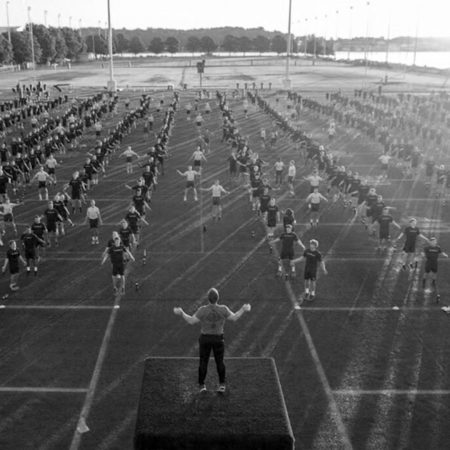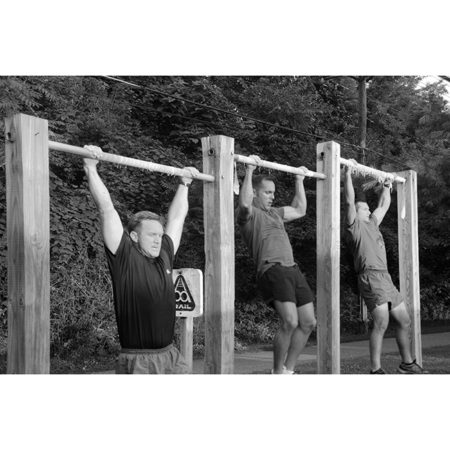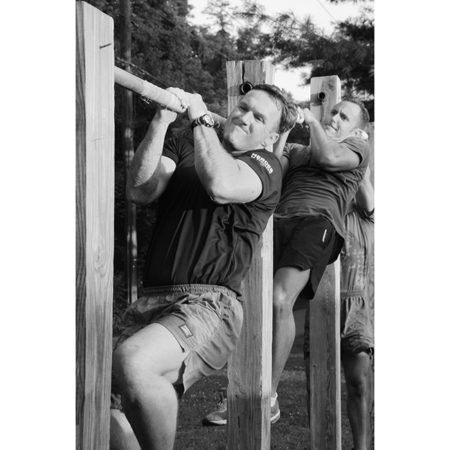This workout is likely as old as the pushup itself and I am not sure who created it. Maybe the Aztecs or Egyptians. Who knows? Pythagoras was into triangles and math so maybe the Greeks. Whoever invented it, it has been a classic workout of mine since the 80s, when I learned it in my teens. Looking back, the pyramid (or ladder) appeared in programs from my football and powerlifting days to reach a one-rep-max with a 5,4,3,2,1 or 10,8,6,4,2 type reverse ladder. And then in the military using it mostly with calisthenics to reach a much higher volume of repetitions. I quickly realized that the pyramid is a perfect workout regardless of calisthenics, weights, running, swimming, and even warming up and cooling down. In fact, the classic PT (physical training) pyramid has a built-in warmup, max out, and cooldown all rolled into one perfect package if you do the 1-10-1 type of pyramid totaling 19 sets.

Because the pyramid is really just a progressive training system that is only limited by your imagination, I like to do them for different types of workouts. If you are not familiar with the beauty, simplicity, and effectiveness of the PT pyramid, here is how it works.
The classic pyramid is where you go up to a level near your max effort and then repeat in reverse order. But you can also do your warmup in pyramid fashion. Just use the “up” portion of the pyramid as a warmup workout mixing in short jogs and dynamic stretches in between sets. (Many would call this just a ladder.) Similarly, you can utilize the “down” portion of your pyramid as a cooldown and take your time to recover, lightly stretch on the easy sets of the pyramid such as 5,4,3,2,1. (You may even call this a reverse ladder.)
You can do multiple “up” sessions to push your max effort several times in a workout simultaneously reaching a high volume. Due to the recovery of starting over again, you can reach a peak of your abilities multiple times if you prefer. (Try two or three rounds of a 1-10 ladder with the below workout and notice the difference in your abilities to reach higher level sets numbers.)

Finally, the pyramid is not just for calisthenics. A reverse ladder (or backside of the pyramid) decreases your repetitions each set making it a perfect time to add weight if you are doing strength work. If running, you can also use pyramids to alter distance (10m, 20m, 30m) or time (one minute, two minutes, three minutes). You can even use them for swimming to control laps and strokes per breath (hypoxic pyramid).
The following pyramid is the classic 1-10-1 format totaling 100 total reps of the pullups x1, pushups x2 (200 reps), and squats x3 (300 reps) spread out over 19 sets and is built on the CrossFit workout “Murph”. Many people replace squats with situps or other core exercises when training for fitness tests and keep these repetitions at the x1, x2, or x3 multiple. You can even add a fourth exercise like dips or a short run of 100 to 400m each set. But, the beauty of this workout is you can exchange exercises as desired (add kettlebell movements, TRX exercises, and sandbags), multiplying levels (x2, x3, etc.), and go as high as you can then repeat in reverse order.
Here are the step by step instructions. Use minimal rest if possible.
- Set 1: 1 pullup, 2 pushups, 3 squats
- Set 2: 2 pullups, 4 pushups, 6 squats
- Set 3: 3 pullups, 6 pushups, 9 squats
- Set 4: 4 pullups, 8 pushups, 12 squats
- Set 5: 5 pullups, 10 pushups, 15 squats (These first sets are basically a warmup)
- Set 6: 6 pullups, 12 pushups, 18 squats
- Set 7: 7 pullups, 14 pushups, 21 squats
- Set 8: 8 pullups, 16 pushups, 24 squats
- Set 9: 9 pullups, 18 pushups, 27 squats
- Set 10: 10 pullups, 20 pushups, 30 squats
- Sets 11-19:9 down to 1 is simply a repeat in reverse order from above.
Back in the 80’s we would do this same workout but with situps (x3) as we prepared for situp tests during military selection programming. Now, you can replace situps with hanging knee ups after pullups, or plank poses x3 (use seconds in the pose instead of repetitions) as the military fitness tests are starting to move away from situps and crunches.
PT Pyramid Assessment Tool
If you are capable, you do not need to stop at set 10, going up to 15 and back down is an advanced level that can yield 225 pullups. That is a lot of volume and not recommended if you have not progressed with this system over time. The great thing about the pyramid is that it is also an assessment tool. One week you may fail at eight and two weeks later eight becomes easy and you reach ten! I have successfully used this method to reach calisthenics numbers in myself and my students in the 100+ pushups, 100+ situps, 20+ pullups zone that made them competitive with most selection training entrance fitness tests.

Ways to Utilize the Pyramid
- Warmup: Mix running with dynamic stretches, you can do a 1-10 pushup or squat pyramid (stop at 10) to get 55 reps of the exercises in 10 sets, mixed with a variety of dynamic stretches during a 25-50 or even 100m jog each set. We will do this either on a basketball court or football field on upper or lower body days as a warmup.
- With calisthenics and weights: I typically like to go up the pyramid with calisthenics but then switch to weights and get heavier each set on the way down the pyramid by adding a weighted version to the same muscle groups. For instance, we will go up the pyramid using pullup x1, pushups x2, abs of choice x3, and dips x2. We stop at set 10 and replace the above exercises with the following weights: weighted pullups (or heavy rows) x1, bench press x1, plank pose 1 min in place of each set of abs of choice, and biceps curl plus military press x2 in place of dips. These are merely suggestions, regardless your choice you get a great warmup, then a tough weighted reverse pyramid.
- Swimming: I like to count sets with the pyramid especially if I am going to 100 laps in a 25m pool. A lap equals 50m and that is set 1, then you do 2 laps, 3 laps, 4 laps, 5 laps…up to 10 and back to 1 for 100 laps or 5000m swim workout. I try to keep the pace at a yard per second and you can take a sip of water between each set of the pyramid if you prefer or stretch a few seconds. It keeps the mind working as well versus just staring at a line at the bottom of the pool.
- Run and burpee or pushup pyramid: This one requires nothing but a place to run (field, court, driveway, etc.) and goes way beyond the warmup model above. This one keeps pushing past set 10 and gets up to 20 or even 25 sets. Typically, if I get up to 20, I do not repeat in reverse order. But with pushups you could repeat in reverse order if you have that ability. The run in between each set can be 25-100m long typically. You will find that the runs become a rest for you during the higher sets so you can bump the distances to 400m even on the higher sets for more running practice and more rest between pushups. When you are able to “rest with running” you are starting to understand how muscle stamina and cardio endurance apply to overall work capacity. Add pullups on one end to make this one really special.
More Favorite Pyramid Workouts
Rules of the PT Pyramid
- Don’t do it every day: Unless you change the exercises to be upper body one day and lower body the next day. This kind of volume of repetitions requires a day off (at least) in between working that muscle group again for best results. For instance, see how I use it with the Classic PST Training Week. The pyramid works well with the super set and the max rep set workout in the same week – EVERY OTHER DAY (or more)!
- Don’t go crazy: When you fail at an exercise, either change the exercise to an easier version or return in reverse order. You can build up some high volume with this workout and not realize it especially on legs and core exercises. Make sure you progress wisely. Don’t do a pyramid with 100 pullups if you have never done more than 15-25 reps in a workout before.
- Don’t be repetitive: Get creative so as to push yourself without hurting yourself. Add exercises. Change your rep or multiple schemes. Adding a diverse group of exercises is fun and allows the body to recovery with active rest by doing a different exercise of a different muscle group. You may find that some core exercises and even a steady jog are a good “rest” activity.
One quick, final, little-known mathematics fact about the PT Pyramid: Squaring the top number of a complete pyramid gives you the total reps of the pyramid you are doing. If you do a 1-10-1 pyramid meaning you start at 1, complete 10 sets, and then reverse the order back to 1, you will have done 100 reps. Do not repeat the top number twice though—this is the Egyptian Pyramid not the Aztec Pyramid (1-10-10-1).






Thanks very much for this article!
I love the sheer simplicity of the pyramid and the fact that it is a great cardio workout if I have virtually no rest between sets.
It has improved my physique and I’ve no doubt it will serve me well in my preparations for fire fighter training this October in the UK.
Also, this program feels easy on the body. My reps for all these exercises are increasing, with no compromise in power or form.
Do you rest at all between sets?
Stew – thank you for this article!
Great read – and always good to be reminded of simple, effective training approaches.
ATB Pete
In 2000, after ten years of lifting in the gym. I came across a couple navy seal fitness books in the library. I started pyramiding regular, diamonds and dive bomber pushups: regular, chin and commando pullups: dips: incline sit ups, incline leg raises, and V-ups: Squats and lungs; hyper extensions. All pyramiding, some times super setting, some times just individually.
After six months, I was probably in the best shape of my life, and all my pain in my shoulders and elbows was gone. I lost twenty pounds
It became nothing to bang out 450 pushups and a couple hundred pullups in a work out.
Great article. Thank you Stew.
Al
You can prove/realize the fact that squaring the top number of the pyramid always gives you the total sum of the reps:
1) By drawing the “up ladder” and the “down ladder” as right triangles with dots representing the reps.
If you fit these two triangles together, you get a perfect square.
2) By using the fact that the sum of the numbers from 1 to n (for example 1 to 10) sum to n*(n+1)/2 (this is easily proved – look up the anecdote of how Gauss did this as a young schoolboy). This gives us the sum of each of the ladders.
When you add the numbers from 1 to n (the “up ladder”) with the numbers from n-1 to 1 (the “down ladder”) it equals adding the numbers n*(n+1)/2 and (n-1)*n/2 (by using the formula above).
When you do a little algebra and simplify the expression n*(n+1)/2 + (n-1)*n/2, you arrive at n^2.
I actually thought up the latter proof and did the calculation a couple of years ago after a pushup pyramid from 1 to 10 by inspiration of Mr. Stew Smith :).
BONUS: Use the formula that the sum of the numbers 1 to n equals n*(n+1)/2 to calculate reps in ladders.
For instance: the ROP-ladder from 1 to 5 equals 5*(5+1)/2=15 reps.
That quick final note was very welcome. I don’t know how many times that I sat down with a calculator adding 1 plus 2 plus 3, etc….
Thanks!